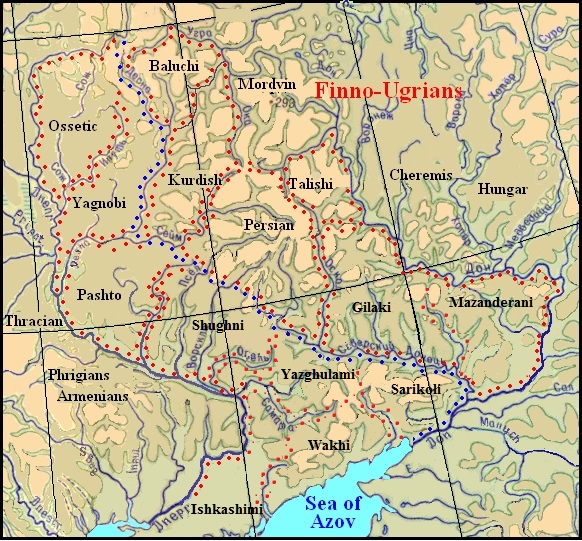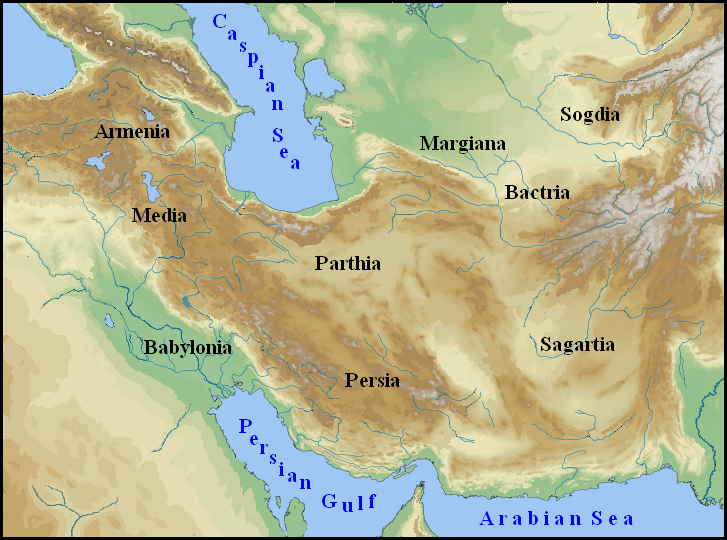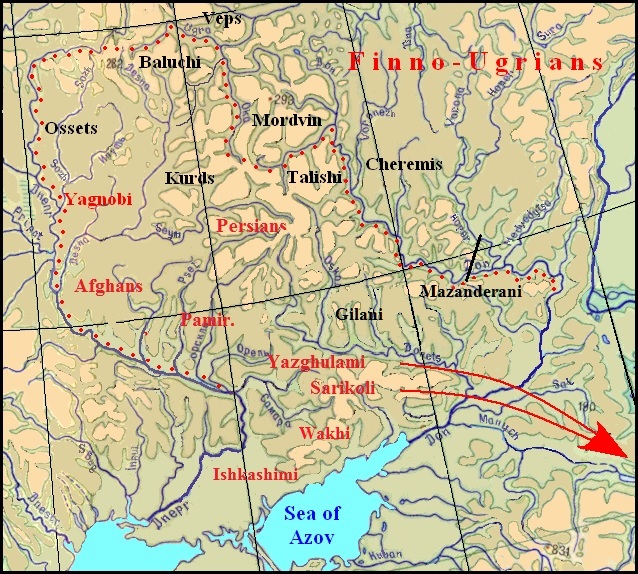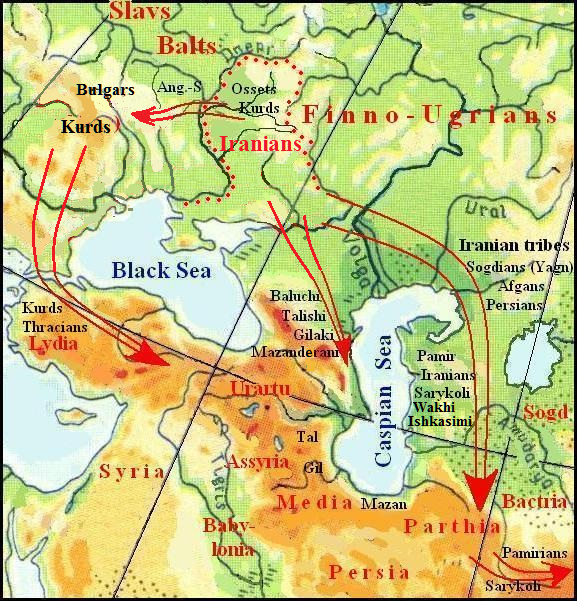Migration of Iranian Tribes
The topic of the migration of Iranians has no sense at all if we proceed from the assumption of the existence of the so-called Indo-Iranian community of the Aryans without an exact idea of its location. Meanwhile, there are still discussions about whether the Aryans are autochthons in the places of their current residence (WITZEL MICHAEL. 2012). In their way of interpreting the selected set of linguistic, anthropological, archaeological, and ethnographic data, scientists come to the question of what and to what extent determines the ethnos. Accordingly, tracing the migration paths of speakers of languages, anthropological types, and cultures, they cannot come to a common opinion and, using formal logical methods, end up engaging in scholasticism. In our research, we focus on the migration of speakers of Iranian languages without regard to their racial type.
The ancestral home of the Iranians, determined by the graphic-analytical method, was located in the ethno-producing areas formed by the left tributaries of the Dnieper and the right tributaries of the Don. As a result, the so-called "East Iranian" languages were formed in the areas in the west of the Iranian territory, stretching along the left bank of the Dnieper. Accordingly, the "Western Iranian" ones were formed in areas along the left bank of the upper Oka and the right bank of the Don, adjacent to the settlements of the Finno-Ugrians (see map below).

At left: The territory of the formation of the Iranian languages in the 2nd millennium BC
On the map, the boundaries of ethno-producing areas are marked with red and blue dots. The blue dots also mark the border between the "western" and "eastern" Iranian languages.
The reasons forcing the Irano-Aryans to leave their original habitats between the Dnieper and the Don may be different. Perhaps the transition of the Balts and the Anglo-Saxons to the left bank of the Dnieper set in motion the local Iranian population of the Zrubna culture. However, we can think about other reasons. Steppe areas could be abandoned due to climate change, which led to a decrease in the productive possibilities of the steppe. In any case, archaeological data indicate a temporary desolation of the Azov and Black Sea regions:
… in the 12th -10th centuries BC compared with the previous period the steppes between the Don and the Danube reveal a tenfold decrease in many settlements and burials. The same trend of population decline is manifested in the Pontic steppe in the subsequent Cimmerian era, which is confirmed by the absence of settlements and stationary burial grounds in this area (MAKHORTYKH S.V., 1997: 6-7).
Thus, the Iranian tribes moved in search of dwelling places with more favorable conditions. It should be kept in mind that the most favorable area for living in the North Caucasus and the Transcaspian region was already inhabited by Turks, so the Iranians were forced to migrate, passing by Turkic settlements further to the south. Evidenced fact is that their presence has been historically recorded in Central Asia at the end of the second millennium BC:
Iranian names appeared in the Assyrian written sources in the 11th- 10th century BC, and are associated with regions of Western Iran that were in the sphere of the political activity of the Assyrian empire. What happened further east at this time – in Central and Eastern Iran – is not reflected in these sources (ARTAMONOV M.I., 1974: 10).

Left: Historical regions in Central and Southwest Asia during the time of the Achaemenid (7th-4th century B.C.)
Historical regions are shown on the map at right, helping to restore the migration routes of Iranian tribes from Eastern Europe to Central Asia
Two points of view exist about the Iran-Aryans' incursions to the Near East – a) the way through Central Asia or b) the way through the Caucasus (PIANKOV I.V., 1979). In North Ossetia, there are many place names containing the element of Gimara, which goes back to the ethnonym of the Cimmerians (TSAGAEVA A. Dz. 2010: 5). However, one cannot exclude the possibility of migration of Iranians to Asia Minor through the Balkans, which is reflected in Hittite sources (SOKOLOV S.N., 1979-2: 235).
Distribution of Iranic Languages
This map is based on work by Dr. of Columbian University Michael Izady (the original is here) .
Studies of ethnogenetic processes have shown that the expansion of the territories of settlements or resettlement of primary ethnic groups proceeds in order of priority in waves following their relative location in the former territories. This important feature during the movement of the Indo-European tribes, according to Gornung, was noted by Franz Specht (GORNUNG B.V. 1963: 53). A comparison of the above maps and the localization of the Iranian ancestral home (STETSYUK VALENTYN. 1998: 76, Fig. 17) suggests that the migration of Iranians responds to this pattern only partially. While the place of residence of modern Ossetians corresponds well to the location of their ancestral home in one of the two northern Iranian areas, the eastern neighbors of the Ossetians, the Baloch, find themselves in the very south of the modern Iranian world. However, it is known that the Baluchi came to Pakistan, where most of them now dwell, from the southern coast of the Caspian Sea in relatively recent times (FROLOVA V.A. 1960: 68, ORANSKY I.M. 1979: 89). Similar explanations should be found for other discrepancies if we assume different routes of movement of migrants. Currently, the Sogdians (ancestors of modern Yagnobis) dwell far from the Ossetians, their neighbors in their ancestral home, but Sogdians were still located in the very north of the Iranian space in Asia. This gives reason to assume that the Sogdians, like the Ossetians, were the last to leave their ancestral home, but unlike the Ossetians who remained in Europe, they continued their journey following the Persians, Afghans, and Pamiri peoples. At the same time, Sogdiana was located north of Afghanistan in the same way as their ancestral home concerning the ancestral home of the Afghans.
The ancestors of the Kurds and Sogdians were neighbors in their ancestral homeland and, moving along the same path, their current places of settlement should have been located, if not next door, then not as far from one another as is the case now. If the Kurds were moving along with the Yaghnobis, then in their movement to present-day Kurdistan they would have to overtake several migrating Iranian groups, which seems incredible. Special studies have shown that the migration routes of the Kurds are very complex and this topic is discussed separately in sections "Cimmerians in Eastern European History" and "Cimbri – Cymry".
Everything suggests that the resettlement of Iranians took place in several waves and ways, and this corresponds to two points of view about the ways of penetration of Iranians into the Middle East – through Central Asia or the Caucasus (PYANKOV I. V. 1979). Obviously, both routes were used, but the main route of most of the Iranians was along the eastern shore of the Caspian Sea, and then along the Amu Darya and Syr Darya to the south and southeast, as described by Kuzmina (KUZMINA E.E. 1986, 203-204). If we talk about the migration of the Baluchis, Gilyans, Talysh, and Mazanderans, then the most likely route for the resettlement of their ancestors would have been through the Derbent Passage. Firstly, this is the shortest route to their modern habitats on the southwestern and southern coasts of the Caspian Sea. Secondly, the areas of their settlements are located in the same order as in their ancestral homeland. If we were going the other way, the location of these areas would be different. But whatever the routes of migration of these Iranian tribes to the Middle East, there is reason to assume that until a certain time they, as well as the ancestors of the Ossetians, although they left their ancestral home under the pressure of the Balts and Anglo-Saxons, remained in Eastern Europe after the first wave of migrants was already in Central Asia.

The beginning of the Iranian migration.
The names of the tribes having formed the first wave of the migration are marked by red color.
Thus, we can assume that the first wave of Iranian immigrants in Central Asia was formed by the ancestors of the modern Sarikolis, Pamir Iranians (Shugnans, Bartangs, Yazgulams, etc.), Persians, Afghans, and Sogdians (Yagnobi), i.e., the Iranian tribes that settled in the southern part of the common Iranian territory and areas along the Dnieper. It is natural to assume that these habitats were once occupied by other Iranian tribes, who for some time remained in Europe. The above-mentioned climate change, which led to a productivity decrease in the steppe, can not lead to its complete abandonment. Another thing is that the newly arrived population to the steppe could not be numerous and to maintain its existence, except for economic activity, was to loot neighboring populations of the forest-steppe zone.
In North Ossetia there are some toponyms containing the Dzhimara element, which goes back to the ethnonym of the Cimmerians (TSAGAYEVA A. Dz. 2010: 5). This should indicate their presence here at some time, and a Kurdish tribe was present among the Cimmerians. However, the bulk of the Cimmerian-Kurds moved to Asia Minor through the Balkans (see Cimmerians in the history of Eastern Europe ). Hittite sources confirmed this (SOKOLOV S.M. 1979-2^ 235)

General picture of the Iranian migration in Minor and Central Asia
Some part of migrated Iranians remained in southern Kazakhstan in the foothills of the western Tien Shan among local Turkic population, as evidenced by the local place names: Madikent/Mankent, Orungent, Syutkent, Chimkent, having a partial word Ir. kent "town, village, space" (POPOVA V.N., 2000, 53).
This word was accepted by Turks and was used for the names of settlements with Turkic components (for example, Tashkent out of taš "stone"). However, Shymkent settlement had to be founded by Iranians, likely by Sogdians (Yagn. čim "meadow, grass"). This interpretation is supported by the name of the Lugovoi village (Russian "on the meadow"), also located in this area, evidently covered by thick grass at that time. There are also Iranian terms of orography of South Kazakhstan darbaza/darvaza "gate, entry, passage", dašt/dešt "steppe, plain, desert", zax/zexab "source, spring" (ibid). It can be assumed that among the Iranians who left these traces in toponymy, there were Sogdians, as well as the ancestors of the Shugnans, Yazgulyams, Vakhans, Sarykols, Ishkashims, and other Pamir peoples. Now they mainly live in the mountain valleys of Badakhshan, but for economic development, the natural conditions here are much worse than on the plain (see map below).
 |
Iranian languages of the Pamirs and surrounding areas
Languages of the world: (Yu. B. Koryakov. 1999. Iranian languages. III. Eastern Iranian languages. M., Academia).
Apparently people moved to the mountains under the pressure of external circumstances. Before the campaign of Alexander the Great, and even for a long time after it, the local population had no reason to leave their homes. Only the invasion of the Seljuks, alien in language and culture to the Iranians, could force him to move to the mountains.
From field notes from the middle of the last century. About expeditions to the Yazgulyam language in the 1950s. (In Russian)
In 1954, the Pamir people were intensively resettled from the Pamirs to the cotton-growing valley regions of Tajikistan under the pretext that labor was needed. In particular, the residents of Yazgulyam, a small high-mountain gorge in the Western Pamirs, were resettled to the Vakhsh Valley (the hottest place in Tajikistan!). For the residents of Yazgulyam, it was a disaster: a hot climate, dirty water in the ditches, widespread illness, and infant mortality… In the spring of 1956, after many petitions, complaints, and scandals, the residents of Yazgulyam were allowed to go back to the Pamirs, to Yazgulyam. And at the end of the summer, I went to see them. This is how I first came to the Pamirs.
This is part of Joy Edelman's notes. Unfortunately, due to Russia's war against Ukraine, access to them has become impossible. Among them, there may be additional data that could help reconstruct Iranian migration more fully.

